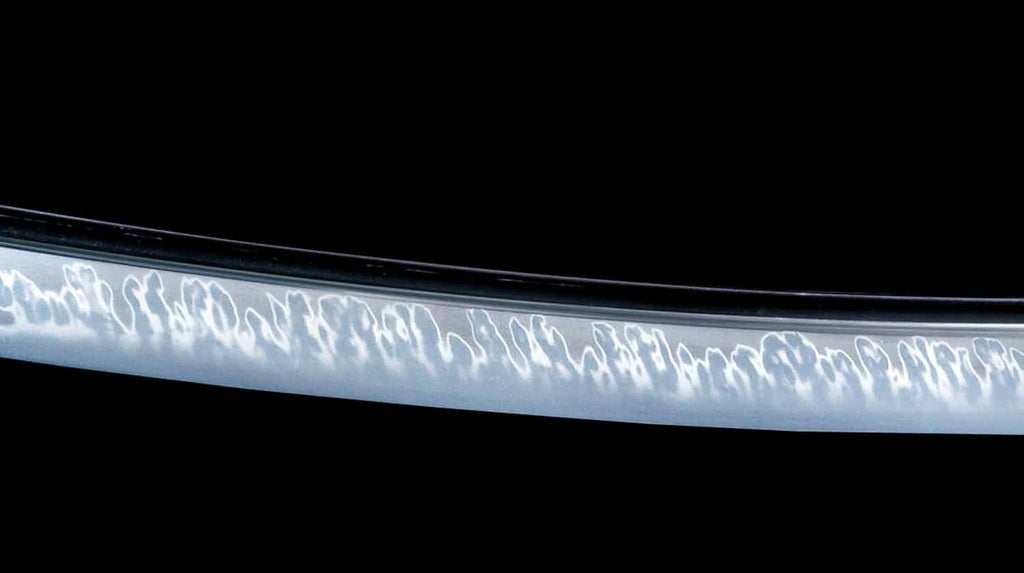There are two types of Japanese swords made by modern swordsmiths: one being what is called a bijutsu-token or "art sword" and the other is called an iaito or "iai sword.” Since there is seldom a clear definition to differentiate between the two, many may have made the judgment based only on a vague concept. We asked the All Japan Swordsmith Association (the largest organization of modern swordsmiths in Japan) about this matter, and the following is the All Japan Swordsmith Association's definition of an art sword and an iaido sword.
The excellence of the Japanese sword as a weapon has long been known. There are many anecdotes about its sharpness. An example would be the tale of Namioyogi Kanemitsu. A criminal received a blow with the Kanemitsu blade but continued to flee, seemingly unharmed. However, after swimming across a nearby river to escape, he suddenly fell and died from the wound that he did not notice he had received. In another such episode, a Ishidorogiri Kotetsu blade being wielded by a samurai cut through a stone lantern with his sword as he attempted to fell an enemy.
Japanese swords, when sharpened and polished to perfection, have a jewel-like luster, and countless people have been enchanted by their beauty. The Japanese sword is thus a weapon that combines both strength and beauty and is not only highly regarded as a world-class artistic expression of Japan, but also as a symbol of the spiritual and cultural symbol of the samurai. As such, it is more than just a weapon.
On the other hand, Japanese swords, no matter how beautiful, were originally created as weapons. The term bijutsu-token did not exist in Japan until before World War II. The term was coined to save valuable swords that had been handed down as family heirlooms to feudal lords and other families during the GHQ occupation immediately after the war from being confiscated and discarded as they may be mistaken with poorly made, mass produced military swords. The Firearms and Swords Control Act enacted after World War II emphasized the artistic aspect of the Japanese sword, and it is said that only swords made of Japanese iron (tatara iron) and made using traditional techniques were permitted to be owned, provided that they were registered as having artistic value.
The Society for Preservation of Japanese Art Swords was established to preserve swords of artistic value, and the term bijutsu-token became firmly established among sword lovers and swordsmiths. With the birth of the this term, swords used in iaido and other activities came to be called iaito, but the difference between the two was never clearly explained and has remained so to this day.
The public is hardly aware of the difference between the two, but to explain the difference simply; an art sword is a sword of high artistic value, as represented by national treasures and important cultural properties, while an iaito is a sword intended for practical use.
Japanese sword exhibitions that have been held since the end of World War II have competed with each other to showcase the beauty of the sword blade production and the handiwork of the craftsmen involved in it, including the Togishi (polisher), Sayashi (sheath craftsman), Shiroganeshi (habaki craftsman), Nurishi (lacquerer), and Tsukamakishi (handle wrapping craftsman.) The swordsmith examines the materials, forges the distinctive jitetsu, pursues beauty in the shape and blade pattern, and produces several blades in order to complete one beautiful sword. Then, the sword is given the highest polish to maximize its beauty. The exterior can then be completed with metal fittings, the handle wrap, and lacquer coating made through the great skill of these other craftsmen. The completed sword is naturally more expensive and has not only superior sharpness but also delicate beauty.
Antique swords designated as national treasures or important cultural properties are masterpieces so brilliant and beautiful that it is hard to believe that they were created by man. The fact that these thousand-year-old swords have been carefully preserved in Japan's hot and humid climate is a miracle in and of itself and is largely due to the beauty of these swords that they were so meticulously cared for over the centuries. Modern swordsmiths who create fine art swords are also passionate about creating beautiful swords that will be handed down to future generations. Even today, when a child is born in the imperial family, the emperor presents the child with a sword for good luck in a ceremony known as Shikennogi. This is just more proof that the Japanese sword has transcended its own purpose as a simple weapon.
On the other hand, iaido swords are designed to be used in iaido and batto. They are made with the emphasis on the shape of the blade, its length, thickness, width, and weight in order to suit the purpose of kata and cutting and are made of various types of iron materials. Some iaido swords use a specially made alloy blade for safety and are intentionally made dull and cannot hold an edge. The polish is simple, with priority given to sharpness in consideration of the possibility of damage during test cutting, and the exterior is mass-produced using inexpensive metal fittings, handle wrap, and chemical based paints.
The difference between a bijutsu-token and an iaito is whether the emphasis is on appreciation or practical use.
All Japan Swordsmiths' Association, 2023

1 comment
Aug 04, 2023 • Posted by Matt
Could you provide any visual examples of the two types of sword polish to help see the difference for iai & appreciation?
Leave a comment: